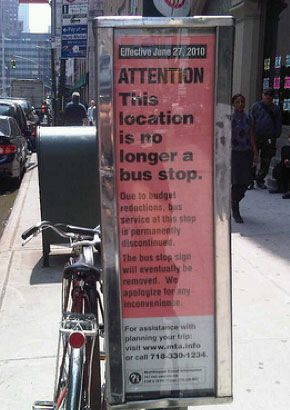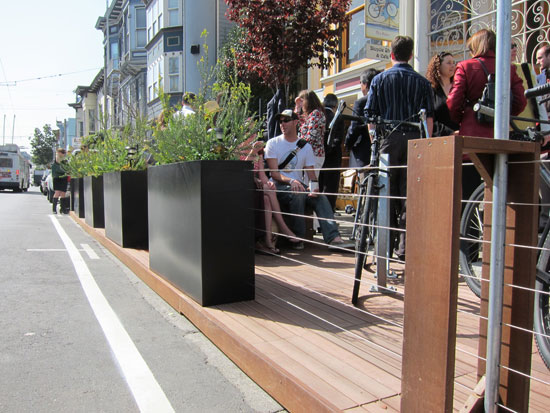If Bus Stops Disappear, What Will Happen to All That Space?
 Photo: cyclosity/Flickr
Photo: cyclosity/Flickr Starting June 27, 570 bus stops across New York City could disappear. Unless Congress delivers an 11th hour reprieve — still a distinct possibility — service cuts will axe or reroute dozens of bus lines, raising the question of what to do with all the curbside real estate at these potentially defunct stops.
Any plan to re-purpose bus stops will be provisional, since the cuts might be averted or service could be restored at a later date. But at least one other city forced to cope with bus cuts has used its defunct stops to promote sustainable transportation and improve the quality of
public space.
In San Francisco’s Mission District, five bus stops were converted to bike corrals, each of which has parking for between six and twelve bikes. In another location, the city made room for a "parklet," a temporary public plaza, by shifting two parking spaces from down the street into the freed-up bus stop space.
Here in New York City, it looks like DOT’s contingency plan does not include re-purposing street space for pedestrian or bike improvements.
At most closed-down bus stops, said an agency spokesperson, the curbside area will simply take on the regulations of the adjoining area. If the street has parking along the curb, for example, the bus stop will become parking. In a few cases, the bus stop might be used for something like a truck loading zone instead.
Advocates are calling for DOT to think creatively about this new space, if the need arises. "Every neighborhood is different and there’s definitely no cookie-cutter solution for all of these bus stops," said Transportation Alternatives’ Wiley Norvell, but in many neighborhoods, the curbside area could be used "to create green space or open space for leisure and recreation." While TA’s goal is to ultimately see bus service restored, said Norvell, "we really hope that the city is using the biggest possible toolbox when reprogramming the space."
 A "parklet" in San Francisco, built on two former parking spaces that were moved to the site of a former bus stop. Photo: Matthew Roth.
A "parklet" in San Francisco, built on two former parking spaces that were moved to the site of a former bus stop. Photo: Matthew Roth.




